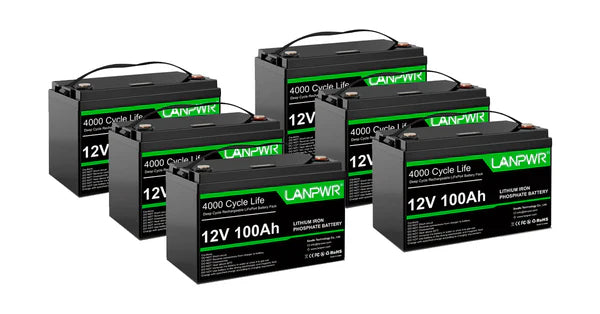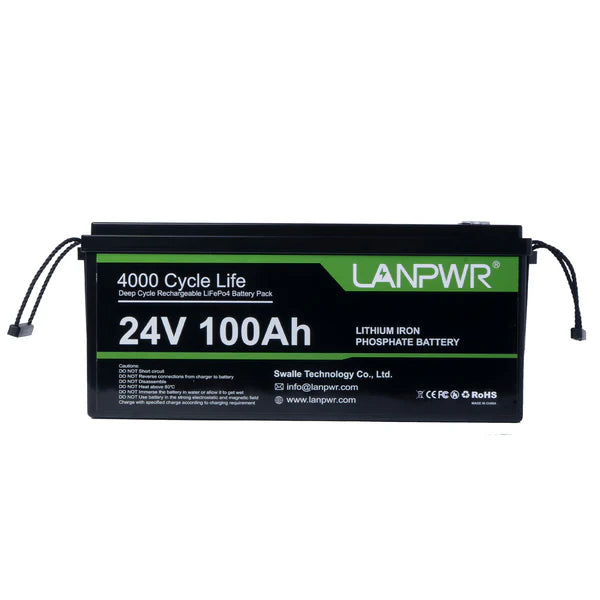Lithium Iron Phosphate (LiFePO4) batteries have received considerable attention in various applications because of their excellent safety, long cycle lives, and flat chemistry compared to other Li-ion batteries. To use LiFePO4 batteries efficiently, one most obviously needs to know and understand their voltage properties. In this piece, we are going to discuss the voltage variations of LiFePO4 batteries, including their nominal voltage, full charge voltage, charge cut-off voltage, discharge cut-off voltage, and implications for diverse use cases.
Most people know that a single LiFePO4 cell has a nominal voltage of 3.2 volts, so let's jump to the main content. The value of this is the battery's voltage around the discharge cycle. The nominal voltage is essential because it helps us decide the total voltage of a battery pack connected to several cells in series. So, for example, a pack made of four cells in series (called a 4S configuration) would have a nominal pack voltage of.
4 cells × 3.2 volts/cell = 12.8 volts
Fully Charged Voltage
A typical fully charged voltage for a LiFePO4 battery cell is 3.6 to 3. When we charge the battery up to this voltage, we know the maximum possible amount of energy has been stored without overcharging it, which damages the health and safety of the battery. A 4-cell LiFePO4 battery pack would have a full charge voltage of:
4 cells × 3.65 volts per cell = 14.6 volts
Always use a charger made specifically for LiFePO4 batteries to avoid overcharging. When overcharging, the battery is more likely to generate heat, and the battery may swell and reach the end of its life.
Discharge cut-off voltage
This is the lowest voltage to which a LiFePO4 cell can safely discharge. In LiFePO4 cells, this goes from 2.0 to 2.5 volts per cell, but it is widely recommended to cut it off at 2.5V to avoid deep discharges as it can be detrimental to the battery "'s health. For a 4-cell pack, the discharge cut-off voltage will be:
4 cells × 2.5 volts per cell = 10 volts
Discharging below this voltage would lead to irreversible damage to the cells, resulting in lower capacity and cycle life in the long term.
Voltage and Pack Configuration: The cell configuration of a LiFePO4 battery pack determines the voltage. Cells can be assembled in series, parallel, or a combination of both to suit the voltage and capacity required.
Series Connection: In a series connection, the voltage is increased, whereas the capacity remains the same as a single cell. This means you would have a pack with a nominal voltage of 12.8 volts (like a 4S LiFePO4 pack, each cell is 3.2 volts).
Parallel Connection (P): The capacity is added up when cells are connected in parallel with the same voltage as one cell. For example, if four cells of 10 Ah capacity are connected parallelly, the pack would have 40 Ah capacity.
S-P (Serial-Parallel) Connection: Combination series a parallel cell to get higher capacity and voltage. The most common format is to use two rows of four cells connected in series to produce a nominal 12.8-volt battery or 4S2P.
Voltage Applications
To use LiFePO4 batteries in practical applications such as electric vehicles, renewable energy storage, marine applications, and portable electronic devices, it is essential to understand their voltage characteristics.
Electric Vehicles (EVs)
LiFePO4 batteries are widely used in electric vehicles for their high safety, long cycle life, and stable voltage. The voltage of the battery pack in an EV establishes the power output and the efficiency. For example, a standard EV could have a 100S configuration (100 cells in series obvs) for a nominal voltage of 320 volts (100 cells x 3.2 volts per cell). In this case, the electric motor is intended for high voltage, resulting in a motor that can deliver lots of power and help the EV provide that same power to the road at the same time the engine wants from the electric motor.
The conversion of energy from a renewable source like the sun or the wind is possible with LiFePO4 batteries that store the energy obtained during the time frame in which production is the highest and deliver energy during the lowest production. The system voltage requirements should equal the voltage of the battery pack. A 48-volt system, for example, could use a 15-cell 3.2 volt per cell LiFePO4 battery pack (15S LiFePO4 = 48 volts nominal). This setup is compatible with conventional solar charge controllers and inverters for renewable energy systems.
LiFePO4 Batteries in Marine Applications
Marine applications are another use of LiFePO4 batteries because of their environmental resistance, stability, and safety. Marine applications have different voltage requirements depending on the equipment and systems used. For a 12-volt system, this could be a 4S LiFePO4 battery pack, while a 24-volt system could use an 8S configuration. This option is ideal because it will always save navigation systems, lighting, and other ship gadgets from failure.
LiFePO4 batteries are used as a clean power source for portable electronics such as laptops, power banks, and medical devices. However, their battery voltage must be the same as the device's to guarantee proper functioning and use. A charge bank might use a 3S (3 cells in series) configuration to give a nominal voltage of 9.6 volts for charging different gizmos.
Charging and Maintenance Tips
Proper charging and maintenance are crucial to getting the most life out of a LiFePO4 battery.
Considerations for Charging
Use an Appropriate Charger: Use a designated LiFePO4 charger to charge your battery. These chargers have the correct voltage and current settings to ensure the convenient recharge of your devices.
Top-off Protection: Lithium cells do not like to be overcharged; over time, it will hurt the lithium cells. Ensure the charger can cut off by itself to prevent overcharging battery cells until they reach their completion voltage (3.6-3.65 volts per cell).
Monitoring Discharge Levels: Ideally, don't let the batteries discharge below the recommended cut-off voltage (2.5 volts per cell). Deep discharging can do permanent cell damage and cut capacity noticeably.
Balance charging: Balance charging charges the battery to complete and then overcharges i. Ith mainly aims to allow for every cell in a pack to be set to the same level, thereby preventing any cell from getting overcharged or over-discharged. Most LiFePO4 battery packs will have an internal Battery Management System (BMS) that manages balancing internally.
Summary
Understanding the voltage characteristic is very important when using the LiFePO4 battery where it is intended to be used. These parameters are the nominal voltage, total charge voltage, and discharge cut-off voltage, which are crucial for the battery's operation and life. Users can fit these cells together in series and parallel connections to form their desired voltage and capacity based on their specific needs. This and proper charging and maintenance are critical components in the durability and reliability of LiFePO 4, making it an excellent option for a wide range of modern energy storage and power supply technologies.














Leave a comment
This site is protected by hCaptcha and the hCaptcha Privacy Policy and Terms of Service apply.